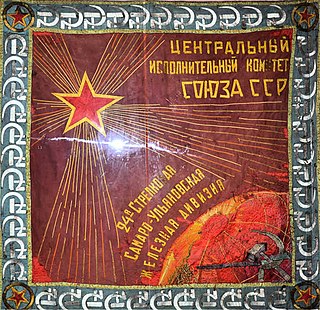Related Research Articles
The 1st Red Banner Army was a Red Army field army of World War II that served in the Soviet Far East.
The 2nd Red Banner Army was a Soviet field army of World War II that served as part of the Far Eastern Front.

The 2nd Cavalry Army was a cavalry army of the Red Army during the Russian Civil War.
The cavalry division of the Soviet Union's Red Army was a type of military formation that existed from the early days of the Russian Civil War until the early 1950s when they became obsolete with the rise of mechanized warfare.
The 11th Rifle Division was a military formation of the Soviet Union's Red Army. Its personnel were involved in the protection of the demarcation line in Pskov, defensive battles against the Army of the Southern Front in Krasnov Novohopersk - Borisoglebsk, against the army and the forces of Estonia, Bulak Balakhovich in Marienburg in defense of Petrograd and as the offensive against Yudenich's troops in Pskov the Luga-Gdov, Yamburg, Narva, Dvina-Rezhitsk directions, the Polish-Soviet war of 1920, in the suppression of the Kronstadt uprising participated in the Soviet-Finnish War and World War II.
The 24th Cavalry Division was a cavalry division of the Red Army during the interwar period and World War II. It was a prewar division assigned to the Transcaucasus Military District on 22 June 1941. The division was assigned there after participating in the Winter War.
The 6th Rifle Corps was a rifle corps of the Soviet Union's Red Army and later the Soviet Army, formed three different times.

A fortified district or fortified region in the military terminology of the Soviet Union, is a territory within which a complex system of defense fortifications was engineered.
The 33rd Rifle Division was a rifle division of the Red Army and Soviet Army, formed twice. The division was formed in 1922 at Samara and moved to Belarus in the next year. It fought in the Soviet invasion of Poland in September 1939 and in the Occupation of Lithuania in June 1940. After Operation Barbarossa, the division fought in the Baltic Operation and Leningrad Strategic Defensive. In January 1942, it fought in the Toropets–Kholm Offensive. The division participated in the Leningrad–Novgorod Offensive, the Pskov-Ostrov Offensive, the Tartu Offensive and the Riga Offensive. In 1945, the division fought in the East Pomeranian Offensive and the Battle of Berlin. The division remained in Germany postwar with the Soviet occupation forces and disbanded in 1947. In 1955, it was reformed from the 215th Rifle Division in the Far East and inherited that division's honorifics, but was disbanded in 1956.
The Orel Military District was a military district of the Russian Soviet Federative Socialist Republic and the Soviet Union. Established in 1918 during the Russian Civil War, the district was disbanded after the end of the war in 1922. It was reestablished during the pre-World War II Soviet buildup in 1938. At the beginning of Operation Typhoon, the German attack on Moscow in October 1941, the district headquarters in the city of Orel was surprised by the German attack and hastily forced to flee the city. After most of the district's territory was occupied, it was disbanded. The district was reformed in 1943 after the area was recaptured and disbanded with the end of World War II in 1945.
The 5th Rifle Corps was a corps of the Soviet Union's Red Army, formed twice.
The 15th Rifle Corps was a rifle corps of the Red Army, formed five times; each formation was a distinct unit unrelated to the others. It was part of the 5th Army. It took part in the Soviet invasion of Poland in 1939.
The 4th Cavalry Corps was a cavalry corps of the Soviet Red Army, formed three times.

The 5th Cavalry Corps was a cavalry corps of the Red Army.
The 19th Rifle Corps was a corps of the Soviet Red Army.

The Kharkov Military District was a military district of the Russian Empire, the Russian Soviet Federative Socialist Republic, and the Soviet Union. Throughout its history, the district headquarters was located in the city of Kharkov in northeastern Ukraine.

The 60th Rifle Division was an infantry division of the Red Army during the Russian Civil War.

The 68th Mountain Rifle Division was a mountain infantry division of the Red Army before and during World War II.
The 2nd Priamur Rifle Division was an infantry division of the Red Army during the interwar period, originally formed as part of the People's Revolutionary Army (NRA) of the Soviet puppet Far Eastern Republic (FER) during the final stages of the Russian Civil War.
The 3rd Cavalry Division was a military unit in the Workers' and Peasants' Red Army of the Armed Forces of the Union of Soviet Socialist Republics.
References
Citations
- ↑ Drig 2019, pp. 17–18, 21.
- ↑ Drig 2019, pp. 30, 33.
- ↑ Drig 2019, p. 99.
- 1 2 Dvoinykh, Kariaeva, Stegantsev, eds. 1993, p. 207.
- 1 2 3 Drig, Yevgeny. "2 кавалерийский корпус имени СНК УССР" [2nd Cavalry Corps named for the Council of People's Commissars of the Ukrainian SSR]. rkka.ru (in Russian). Archived from the original on 4 May 2014. Retrieved 21 April 2017.
- ↑ "2-й кавалерийский корпус" [2nd Cavalry Corps]. tankfront.ru (in Russian). Retrieved 21 April 2017.
Bibliography
- Drig, Yevgeny (2019). Войска Семена Михайловича. История организационного строительства стратегической конницы РККА[The Troops of Semyon Mikhailovich: A History of the Organizational Development of the Strategic Cavalry of the Red Army] (in Russian). Moscow: Fond "Russkiye Vityazi". ISBN 978-5-6041924-3-6.
- Dvoinykh, L.V.; Kariaeva, T.F.; Stegantsev, M.V., eds. (1993). Центральный государственный архив Советской армии: Путеводитель [Central State Archive of the Soviet Army Guidebook] (in Russian). Vol. 2. Minneapolis: Eastview Publications. ISBN 1-879944-03-0. Archived from the original on 2017-04-21. Retrieved 2017-04-21.